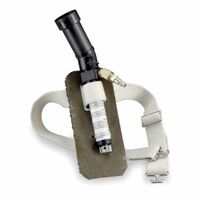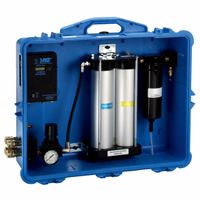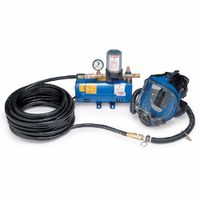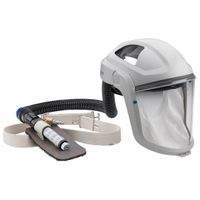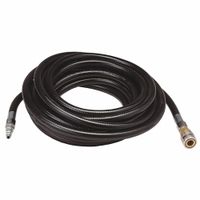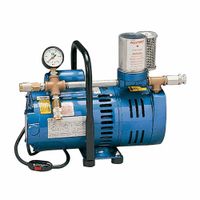Call +(254) 703 030 000 / 751 483 999 / 721 704 777
- Home
- Safety
- Respiratory Protection
- Sar Supplied Air Respirator Systems Components
.....Read More
Frequently Asked Questions
What is a supplied-air respirator (SAR) system?
A Supplied-Air Respirator (SAR) system, also known as an airline respirator, is a type of respiratory protection device that provides clean, breathable air from a source outside the contaminated area. It is designed to protect users from inhaling hazardous substances in environments where air quality is compromised, such as in industrial settings, chemical plants, or during hazardous material handling.
The SAR system consists of several key components:
1. **Air Source**: This can be a high-pressure compressor, compressed air cylinders, or an ambient air pump. The air source must deliver Grade D breathable air, which is free from contaminants and has the appropriate oxygen levels.
2. **Airline Hose**: A flexible hose connects the air source to the user’s facepiece or hood. The hose must be durable and resistant to kinks or damage to ensure a continuous supply of air.
3. **Facepiece or Hood**: The user wears a facepiece (full-face or half-mask) or a hood that covers the head and neck. This component is designed to create a seal around the face or head to prevent contaminated air from entering.
4. **Regulator and Valves**: These control the flow and pressure of the air delivered to the user, ensuring a consistent and safe supply.
SAR systems are particularly useful in environments where the air is immediately dangerous to life or health (IDLH) or where the concentration of contaminants is unknown or exceeds the capacity of air-purifying respirators. They offer the advantage of a continuous supply of fresh air, reducing the risk of exposure to harmful substances. However, they require careful management of the air supply and hose length, as mobility can be limited by the hose connection.
How does a supplied-air respirator differ from a self-contained breathing apparatus (SCBA)?
A supplied-air respirator (SAR) and a self-contained breathing apparatus (SCBA) are both types of respiratory protection equipment, but they differ in their design, functionality, and applications.
A supplied-air respirator (SAR) provides clean air from a remote source through a hose. The air source can be a compressor or a cylinder located away from the hazardous environment. SARs are suitable for long-duration tasks as they offer a continuous supply of air, but their mobility is limited by the hose length. They are often used in environments where contaminants are present but not immediately life-threatening, such as in painting, chemical handling, or confined spaces with known hazards.
In contrast, a self-contained breathing apparatus (SCBA) is an independent system that provides breathable air from a tank carried by the user. SCBAs are designed for high-risk environments where the air is immediately dangerous to life or health (IDLH), such as firefighting, rescue operations, or hazardous material handling. They offer complete mobility and are not restricted by hoses, but their usage time is limited by the air supply in the tank, typically ranging from 30 to 60 minutes.
In summary, the key differences are:
1. Air Source: SAR uses a remote air supply; SCBA uses an on-person air tank.
2. Mobility: SAR is limited by hose length; SCBA offers full mobility.
3. Duration: SAR can provide air for extended periods; SCBA is limited by tank capacity.
4. Application: SAR is for non-IDLH environments; SCBA is for IDLH conditions.
What are the advantages of using a supplied-air respirator in non-IDLH environments?
Supplied-air respirators (SARs) offer several advantages in non-IDLH (Immediately Dangerous to Life or Health) environments:
1. **Extended Protection**: SARs provide a continuous supply of clean air from an external source, ensuring protection from contaminants over extended periods, unlike air-purifying respirators that rely on filters which can become saturated.
2. **Consistent Air Quality**: They deliver a consistent quality of breathable air, which is crucial in environments with variable contaminant levels or where the concentration of hazardous substances is unknown or fluctuating.
3. **Reduced Breathing Resistance**: Since the air is supplied under pressure, SARs reduce the effort required to breathe, which can be beneficial for workers engaged in physically demanding tasks or those who may have respiratory issues.
4. **Versatility**: SARs can be used in a variety of settings, including those with low oxygen levels, as they do not rely on ambient air. This makes them suitable for confined spaces or areas with poor ventilation.
5. **Comfort and Safety**: The continuous airflow can help keep the wearer cool, enhancing comfort during long work shifts. Additionally, the positive pressure inside the mask helps prevent contaminants from entering in case of minor leaks.
6. **Longer Work Duration**: Unlike self-contained breathing apparatus (SCBA), which is limited by the air supply in the tank, SARs can be used for longer durations as they are connected to a stationary air source.
7. **Cost-Effectiveness**: Over time, SARs can be more cost-effective than disposable respirators, especially in environments where respirators are used frequently or for long durations.
8. **Reduced Maintenance**: With fewer components to replace compared to other respirators, SARs often require less maintenance, reducing downtime and operational costs.
How long can a worker use a supplied-air respirator continuously?
The duration a worker can use a supplied-air respirator continuously depends on several factors, including the type of respirator, the work environment, and regulatory guidelines. Generally, there is no specific time limit set universally, but several considerations must be taken into account:
1. **Type of Respirator**: Supplied-air respirators (SARs) can be either continuous flow, demand, or pressure-demand types. The design and comfort level of the respirator can affect how long it can be worn.
2. **Work Environment**: The level of contaminants, temperature, humidity, and physical demands of the task can influence the duration of use. High temperatures or physically demanding tasks may require more frequent breaks.
3. **Regulatory Guidelines**: Occupational Safety and Health Administration (OSHA) and other regulatory bodies may have specific guidelines or recommendations for respirator use. OSHA requires that respirators be used in accordance with a comprehensive respiratory protection program, which includes work/rest schedules.
4. **Manufacturer's Instructions**: The respirator's manufacturer may provide specific guidance on the duration of use based on the design and intended use of the equipment.
5. **Worker Comfort and Safety**: Continuous use should not compromise the worker's comfort or safety. Regular breaks are recommended to prevent fatigue, dehydration, and other health issues.
6. **Air Supply**: The duration is also limited by the air supply. For example, if using a cylinder, the air supply duration will dictate the maximum time of continuous use.
In practice, it is essential to follow a respiratory protection program that includes regular breaks, monitoring of the worker's condition, and adherence to safety guidelines to ensure the safe and effective use of supplied-air respirators.
What are the limitations of using a supplied-air respirator?
Supplied-air respirators (SARs) have several limitations:
1. **Mobility Constraints**: SARs are tethered to an air supply, limiting the user's range of movement. The hose can restrict access to confined spaces or areas with obstacles.
2. **Hose Hazards**: The air supply hose can be a tripping hazard and may become entangled or damaged, compromising the air supply.
3. **Air Supply Dependency**: Users are dependent on a continuous, uncontaminated air supply. Any interruption or contamination in the air source can pose serious risks.
4. **Limited Duration**: The duration of use is limited by the air supply capacity, which may require frequent monitoring and management.
5. **Complex Setup**: SARs require a more complex setup compared to other respirators, including ensuring a secure connection to the air source and proper hose management.
6. **Maintenance Requirements**: Regular maintenance and inspection are necessary to ensure the system's integrity and functionality, which can be resource-intensive.
7. **Training Needs**: Users require comprehensive training to operate SARs effectively, including understanding the equipment's limitations and emergency procedures.
8. **Cost**: SARs can be more expensive than other types of respirators due to the need for additional equipment like air compressors and hoses.
9. **Environmental Limitations**: SARs may not be suitable for environments with sharp objects or rough surfaces that could damage the hose.
10. **Communication Challenges**: The equipment can hinder verbal communication, necessitating additional communication tools or methods.
11. **Weight and Bulk**: The equipment can be bulky and heavy, potentially causing fatigue over extended use periods.
12. **Temperature Sensitivity**: Extreme temperatures can affect the performance of the air supply system and the comfort of the user.
How do you maintain and clean a supplied-air respirator system?
To maintain and clean a supplied-air respirator system, follow these steps:
1. **Inspection**: Before each use, inspect the respirator for damage, wear, or contamination. Check hoses, facepieces, and connections for cracks, tears, or deformities. Ensure all components are functioning properly.
2. **Cleaning**: After each use, disassemble the respirator according to the manufacturer's instructions. Clean the facepiece and other components with warm water and mild detergent. Use a soft brush to remove dirt and debris. Rinse thoroughly with clean water to remove any soap residue.
3. **Disinfection**: After cleaning, disinfect the respirator using a solution recommended by the manufacturer, typically a mixture of water and bleach or a commercial disinfectant. Soak the components for the recommended time, then rinse thoroughly with clean water.
4. **Drying**: Allow all parts to air dry completely in a clean, non-contaminated area. Avoid direct sunlight or excessive heat, which can damage the materials.
5. **Reassembly**: Once dry, reassemble the respirator according to the manufacturer's instructions. Ensure all parts are securely connected and functioning properly.
6. **Storage**: Store the respirator in a clean, dry place away from direct sunlight, chemicals, and extreme temperatures. Use a storage bag or container to protect it from dust and contaminants.
7. **Regular Maintenance**: Perform regular maintenance checks as per the manufacturer's guidelines. Replace filters, cartridges, and other consumable parts as needed. Keep a maintenance log to track inspections, cleanings, and part replacements.
8. **Training**: Ensure all users are trained in the proper use, cleaning, and maintenance of the respirator system. Regularly review procedures to ensure compliance with safety standards.
By following these steps, you can ensure the respirator system remains effective and safe for use.
What safety standards and regulations apply to supplied-air respirators?
Supplied-air respirators (SARs) are subject to various safety standards and regulations to ensure their effectiveness and user safety. In the United States, the primary regulatory body is the Occupational Safety and Health Administration (OSHA), which mandates compliance with specific standards for respiratory protection under 29 CFR 1910.134. This regulation outlines requirements for the selection, use, and maintenance of respirators, including SARs, in workplaces.
The National Institute for Occupational Safety and Health (NIOSH) is responsible for testing and certifying respirators, including SARs, under 42 CFR Part 84. NIOSH certification ensures that respirators meet minimum performance criteria for filtration efficiency, breathing resistance, and other critical factors.
The American National Standards Institute (ANSI) also provides guidelines through ANSI/ASSE Z88.2, which offers comprehensive recommendations for respiratory protection programs, including the selection and use of SARs. This standard emphasizes the importance of proper fit testing, training, and maintenance.
In Europe, the European Union's PPE Regulation (EU) 2016/425 governs the design and manufacture of personal protective equipment, including SARs. Compliance with this regulation is demonstrated through the CE marking, which indicates conformity with health, safety, and environmental protection standards.
Additionally, the International Organization for Standardization (ISO) provides global standards, such as ISO 16900 series, which cover performance requirements and testing methods for respiratory protective devices.
Employers must ensure that SARs are used in accordance with these standards and regulations, which include conducting hazard assessments, providing training, and implementing a comprehensive respiratory protection program. Regular inspections, maintenance, and fit testing are crucial to ensure the continued effectiveness and safety of SARs in protecting workers from hazardous environments.
